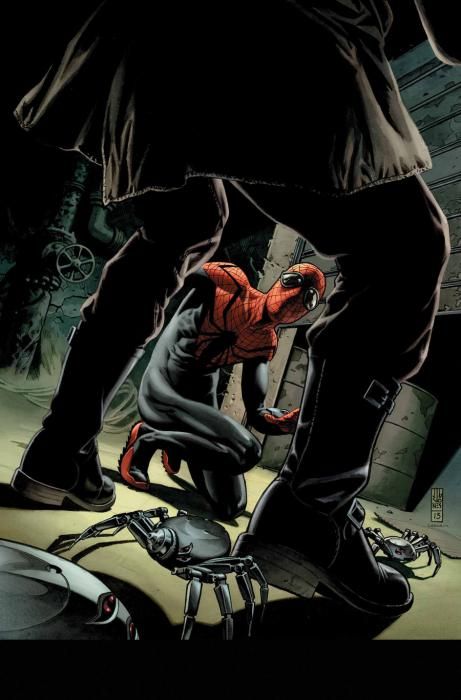With thirty pages of story -- no back-ups, reprints or biography pages, just ten more pages than the regular offering -- allowing "Superior Spider-Man Annual" #1 to have a little more room to stretch out and breathe, writer Christos Gage and artist Javier Rodriguez bring back Blackout. That's right, the villain absolutely no one has been asking Marvel to bring back and match up against the Otto Octavius-fueled Spider-Man gets a chance to rise again. As is clarified in this issue, the Blackout in question is the one known as a foe of the Danny Ketch version of Ghost Rider, not the Nova foe from the 1970s.
Pulling double duty on the pencils and the colors, Javier Rodriguez delivers a visibly timeless tale that tightly focuses on Peter Parker (such as he is), Jay Jameson, Aunt May and Blackout, with a couple deeper visual nods to the historical Marvel Universe in the form of Doctor Octopus, Doctor Strange and Ghost Rider. Rodriguez fills the pages quite nicely, making smart decisions about when to explode with details in the backgrounds and when to forego scenery for emotion. His colors are as dynamically brilliant in this comic book as they are every issue of "Daredevil," which gives "Superior Spider-Man Annual" #1 a tonal echo similar to that of ol' Hornhead. Rodriguez's pencil work isn't that far a departure from Chris Samnee, but it is a few steps away from Humberto Ramos, Ryan Stegman and Giuseppe Camuncoli. It's not better or worse, mind you, it's just different. It fits the story of Spider-Man doing everything he can to rescue Aunt May from Blackout. The heavy shadow work of Alvaro Lopez makes the colors pop off the page all the more, giving Rodriguez plenty of room to shine.
Gage's story takes the notion of Peter Parker being a marked man and flips it on its ear. First, however, we have to endure threats to Aunt May's livelihood. Those threats don't carry much weight and never really seem threatening enough throughout this story. Enraged that such a predicament could result from Parker publicizing his fraternization with Spider-Man, Octavius-Parker vows to rectify the situation. The extremes that Gage pushes the character to work for the story, but seem to have projected ramifications that just continue to muddy the waters "Superior Spider-Man" lives in. Gage is clearly comfortable with this incarnation of Spider-Man, giving Parker ample opportunity to rave like the deranged, displaced lunatic he is. The story itself, however, seems as though it could have fit better in a single issue or as a two-parter, rather than not quite filling the limits of capacity afforded by the thirty pages in "Superior Spider-Man Annual" #1.
While Blackout might not be the greatest villain to pit against Spider-Man, Gage and Rodriguez make a solid story of it. The outcome of "Superior Spider-Man Annual" #1 is going to have definite ramifications on the lives of Spider-Man and Peter Parker for issues to come, and the final page of this issue confirms that those ramifications will only be in addition to the machinations already underway thanks to dramatic return of one of Spider-Man's most sinister foes. This is as solid a read as any issue since the mind-swap between Parker and Octavius, but it lacks soul. There are consequences in store, but they seem temporary until things magically find themselves undone. I'd like to see Gage build on this, but I'm sure he's more than comfortable to hand the next steps in this adventure over to regular "Superior Spider-Man" writer Dan Slott.

